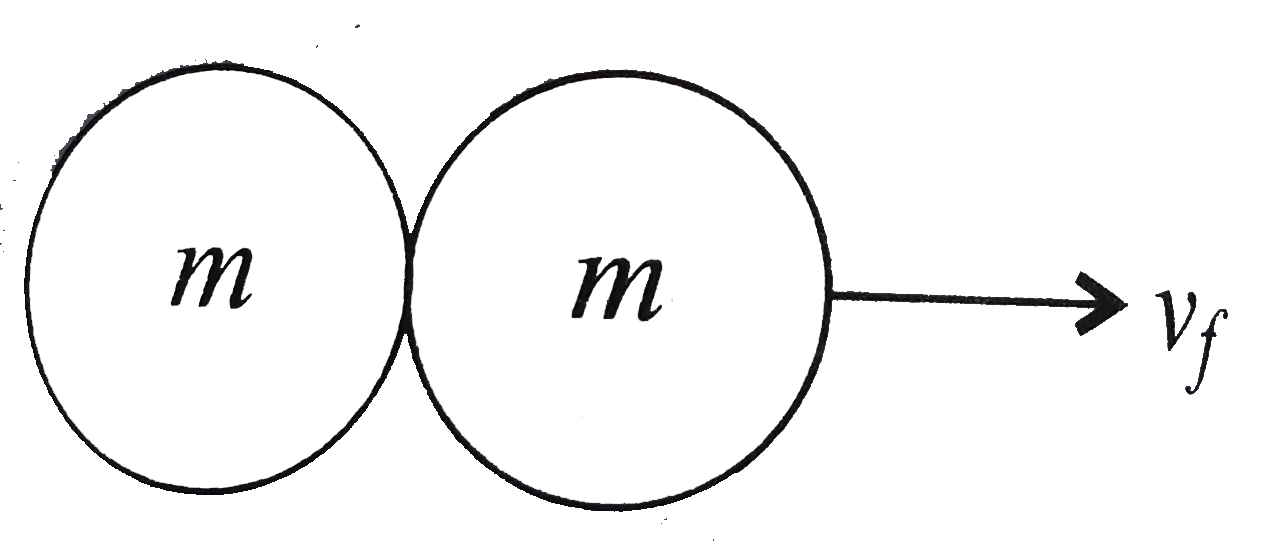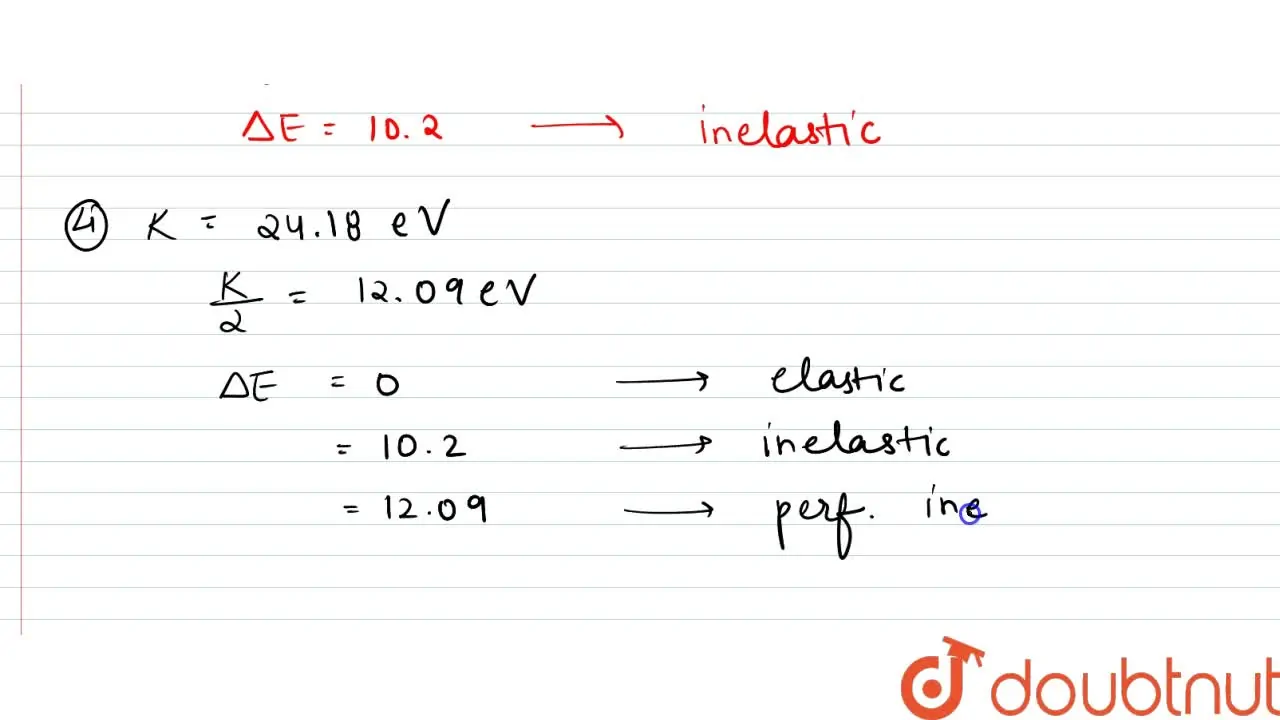In the figure , what type of collision can be possible , if K = 14 eV, 20.4 eV,22 eV, 24.18 eV,(elastic // inelastic // perfectly inelastic).

Loss in (ΔE) during the collision will be need to excite the atom of electron from one level to another. Acceleration to Bohr 's theory, for hydrogen atom.
ΔE=(0,10.2eV,12.09eV,….13.6eV)
Acceleration to Newtonion machanics, minimum loss =0 for elestic collision, For maximum loss, collision will be perfectly inelastic.

If neutron collides perfectly inelastically , then applying momentum conservation ,
mv0=2mvf⇒vr=v02
Final KE=12×2m×v204=12mv202=K2
So, maximum loss = K2
According to classical mechaincs, energy loss lies in the range :
ΔE=[0,K2]
a. K=14eV:According to quantum mechaincs,
ΔE={0,10.2eV,12.09eV}
Acceleration to classic machanics ΔE=[0.7eV]
So, possible less =0, hence it is an classic collision.
b. K=20.4eV:According to quantum mechaincs,
ΔE={0,10.2eV,12.09eV....}
Acceleration to classic machanics ΔE=[10.2eV]
If possible less =0 ⇒ classic collision ,
If less =10.2eV ⇒ inelastic collision (not perfectly),
and If loss =12.09eV⇒ perfectly inclastic collision.
Related Playlists
- BOOK - CENGAGE PHYSICS ENGLISHCHAPTER - ATOMIC PHYSICSEXERCISE - Solved Examples23videos
ATOMIC PHYSICS
- BOOK - CENGAGE PHYSICS ENGLISHCHAPTER - ATOMIC PHYSICSEXERCISE - Exercise 4.115videos
ATOMIC PHYSICS
- BOOK - CENGAGE PHYSICS ENGLISHCHAPTER - ALTERNATING CURRENTEXERCISE - Single Correct10videos
ALTERNATING CURRENT
- BOOK - CENGAGE PHYSICS ENGLISHCHAPTER - CAPACITOR AND CAPACITANCEEXERCISE - Integer5videos
CAPACITOR AND CAPACITANCE
Similar Questions
A vertically jet of water coming out of a nozzle with velocity 20m/s supports a plate of mass M stationary at a height h=15m, as shown in the figure. If the rate of water flow is 1 litre per second, the mass of the plate is (Assume the collision to be perfectly inelastic).
 View Solution
View SolutionA particle of mass m strikes a disc of radius R and mass m with a speed u as shown in the figure. What is the speed of the particle just after the collision if the collision is perfectly inelastic ?
 View Solution
View SolutionA ball is projected from the point O with velocity 20 m/s at an angle of 60∘ with horizontal as shown in figure. At highest point of its trajectory it strikes a smooth plane of inclination 30∘ at point A. The collision is perfectly inelastic. The maximum height from the ground attained by the ball is (g=10m/s2)
 View Solution
View SolutionAn object of mass 80 kg moving with velocity 2ms−1 hit by collides with another object of mass 20 kg moving with velocity 4ms−1 Find the loss of energy assuming a perfectly, inelastic collision
View SolutionAn object of mass 80 kg moving with velocity 2ms−1 hit by collides with another object of mass 20 kg moving with velocity 4ms−1 Find the loss of energy assuming a perfectly, inelastic collision
View SolutionThe work function for the following metals is given Na: 2.75 eV, K:2.30 eV , Mo: 4.17 eV , Ni: 515 eV.
Which of these metals will not give photoelectric emission for a radiation of wavelength 3300 A from a He−Cd laser placed 1m away from the photocell? What happens if the laser is brought nearer and placed 50 cm away?View SolutionThe ionisation potentials of Li and K are 5.4 and 4.3 eV respectively. The ionization potential of Na will be:
View SolutionA : Work function of aluminium is 4.2 eV . Emission of electrons will be possible by two photons , each of 2.5 eV energy , striking the electron of aluminium .
R : Energy of a photon can be less then the work function of the metal , for photoelectron emission .View SolutionIn a mixture of He⊕ gas H atom and He⊕ ions Are excited to three respective first excited subsepuenly , H atom transfers its total excitation energy to He⊕ions by collision .Assuming that Bohr model of an atom is applicable , answer the following question
If each hydrogen atom in the ground state of 1.0mol of H atom is excited by absorbing photon of energy 8.4eV,12.09eV and 15.0eV of energy then the number of spectral lines emitted is equal toView SolutionThe work function for Al, K and Pt is 4.28 eV, 2.30 eV and 5.65 eV respectively. Their respective threshold frequencies would be
View Solution


